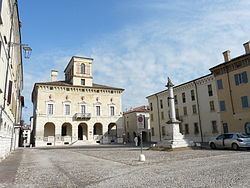Time zone CET (UTC+1) | Elevation 18 m (59 ft) Local time Monday 2:30 PM | |
 | ||
Frazioni Breda Cisoni, Ca' de Cessi, Commessaggio Inferiore, Ponteterra, Villa Pasquali Weather 16°C, Wind NE at 10 km/h, 34% Humidity Points of interest Teatro all'antica, Palazzo Ducale, Galleria degli Antichi an, Sinagoga, Chiesa della Beata Vergine I | ||
Sabbioneta is a town and comune in the province of Mantua, Lombardy region, Northern Italy. It is situated about 30 kilometres (19 mi) north of Parma, not far from the northern bank of the Po River. It was inscribed in the World Heritage List in 2008.
Contents
Map of 46018 Sabbioneta Province of Mantua, Italy
History
Sabbioneta was founded by Vespasiano I Gonzaga in the late 16th century along the ancient Roman Via Vitelliana, on a sandy bank of the Po (whence the name, meaning "Sandy" in Italian); he was its first duke, using it as a personal fortress and residence.
It was also during this period that it became a minor musical centre; composers such as Benedetto Pallavicino (c. 1551-1601) were employed here by Vespasiano Gonzaga, prior to his moving to the main Gonzaga city of Mantua.
Main sights
In 2008, Sabbioneta was inscribed in the UNESCO World Heritage List as a recognition of its perfect example of practical application of Renaissance urban planning theories.
Sabbioneta is also known for its historic Jewish Ghetto and Synagogue, and in particular for its Hebrew printing-press. In 1551 Tobias Foa set up the press; he had, however, published certain "anti-Christian books" and his career was "forcibly ended". His work and possibly his type were taken up by a Christian printer, Vicenzo Conte.
Vespasiano Gonzaga's town, designed according to the Renaissance principles of the Ideal City, included:
The church and the summer palace contain frescoes by artists of the Campi family of Cremona.
